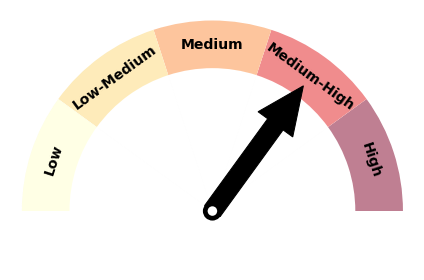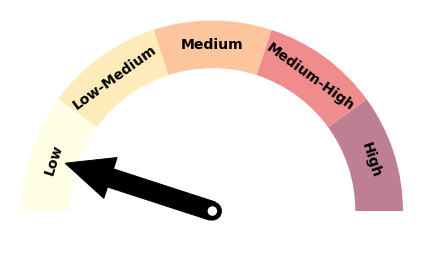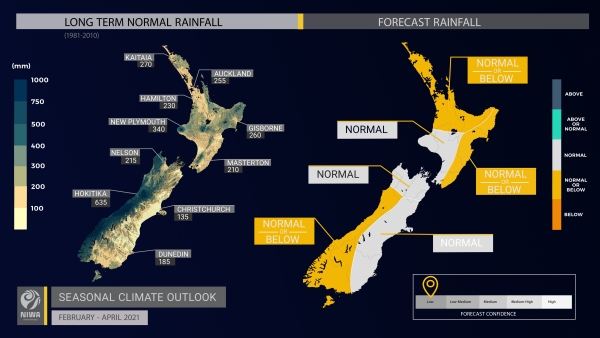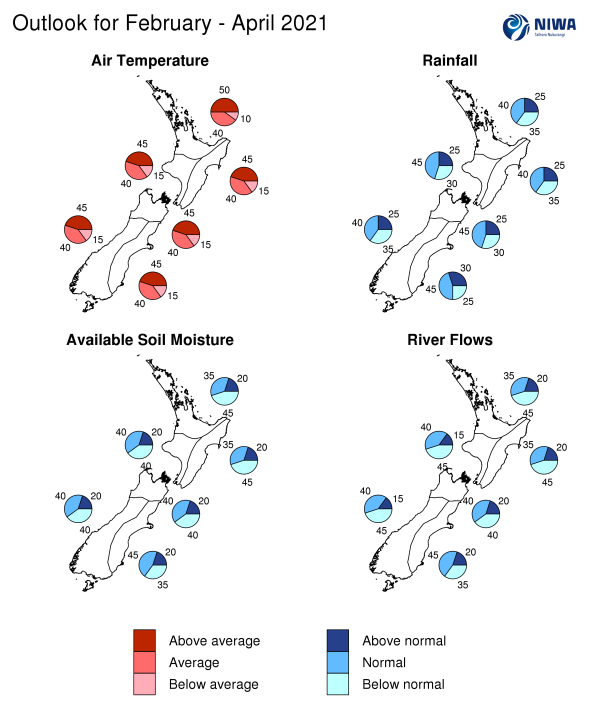Outlook Summary
- The tropical Southwest Pacific may have intermittent cyclone activity during February. Should one of these features or their moisture affect New Zealand, heavy rainfall that can cause flooding would be possible for some regions, but it isn’t possible to predict where it would happen weeks in advance.
- On average, one ex-tropical cyclone passes near the country each year. Significant rainfall, damaging winds, and coastal inundation can occur during these events.
- Otherwise, high pressure is expected to be a prominent feature in the New Zealand region, leading to more extended dry spells over the upcoming three months.
- So far this summer, the country’s climate patterns have been influenced by a non-traditional central Pacific La Niña. This is expected to continue over the next three months.
- An example of the impact of the non-traditional La Niña is the ongoing unusually dry conditions across parts of the northern and eastern North Island, according to NIWA’s New Zealand Drought Index. Meteorological drought is occurring in the Far North and East Cape.
- Air pressure is forecast to be higher than normal in the New Zealand region and lower than normal to the north of the country. This is expected to be associated with mixed easterly and southwesterly quarter air flow anomalies.
- Temperatures are most likely to be above average in the north of the North Island and about equally likely to be near average or above average in all other regions.
- Patterns of high pressure and occasional tropical winds will continue to produce periods of above average warmth into autumn, although variable air flow patterns can allow for some cooler air masses to emerge from the Southern Ocean from time to time.
- Rainfall is about equally likely to be near normal or below normal in the north and east of the North Island and west of the South Island. Near normal rainfall is expected in all other regions.
- Coastal sea surface temperature (SST) anomalies ranged from 0.3 to 0.7˚C above average during January. Marine heatwave developed north of the country.
- Soil moisture levels and river flows are most likely to be below normal in the north and east of the North Island, near normal in the east of the South Island, and equally likely to be near normal or below normal in the remaining regions of the country.
Regional predictions for February – April 2021
Northland, Auckland, Waikato, Bay of Plenty
The table below shows the probabilities (or percent chances) for each of three categories: above average, near average, and below average. In the absence of any forecast guidance there would be an equal likelihood (33% chance) of the outcome being in any one of the three categories. Forecast information from local and global guidance models is used to indicate the deviation from equal chance expected for the coming three-month period, with the following outcomes the most likely (but not certain) for this region:
- Temperatures are most likely to be above average (50% chance).
- Rainfall totals are about equally likely to be near normal (40% chance) or below normal (35% chance).
- Abnormally dry conditions are occurring across the western Bay of Plenty, northern Waikato, Auckland, and Northland according to NIWA’s New Zealand Drought Index. Meteorological drought and severe meteorological drought are occurring in Northland’s Far North District.
- Extended dry spells are expected to continue with the potential for sporadic heavy rainfall.
- Soil moisture levels and river flows are most likely to be below normal (45% chance).
The full probability breakdown is:
|
Temperature |
Rainfall |
Soil moisture |
River flows |
|
|
Above average |
50 |
25 |
20 |
20 |
|
Near average |
40 |
40 |
35 |
35 |
|
Below average |
10 |
35 |
45 |
45 |
Central North Island, Taranaki, Whanganui, Manawatu, Wellington
Probabilities are assigned in three categories: above average, near average, and below average.
- Temperatures are about equally likely to be above average (45% chance) or near average (40% chance).
- Rainfall totals are most likely to be near normal (45% chance).
- Soil moisture levels and river flows are about equally likely to be below normal (40-45% chance) or near normal (40% chance).
The full probability breakdown is:
|
Temperature |
Rainfall |
Soil moisture |
River flows |
|
|
Above average |
45 |
25 |
20 |
15 |
|
Near average |
40 |
45 |
40 |
40 |
|
Below average |
15 |
30 |
40 |
45 |
Gisborne, Hawke’s Bay, Wairarapa
Probabilities are assigned in three categories: above average, near average, and below average.
- Temperatures are about equally likely to be above average (45% chance) or near average (40% chance).
- Rainfall totals are about equally likely to be near normal (40% chance) or below normal (35% chance).
- Abnormally dry conditions are occurring across Gisborne, Hawke’s Bay, and Wairarapa according to NIWA’s New Zealand Drought Index. Meteorological drought is occurring in East Cape.
- Soil moisture levels and river flows are most likely to be below normal (45% chance).
The full probability breakdown is:
|
Temperature |
Rainfall |
Soil moisture |
River flows |
|
|
Above average |
45 |
25 |
20 |
20 |
|
Near average |
40 |
40 |
35 |
35 |
|
Below average |
15 |
35 |
45 |
45 |
Tasman, Nelson, Marlborough, Buller
Probabilities are assigned in three categories: above average, near average, and below average.
- Temperatures are about equally likely to be above average (45% chance) or near average (40% chance).
- Rainfall totals are most likely to be near normal (45% chance).
- Abnormally dry conditions are occurring across Marlborough according to NIWA’s New Zealand Drought Index.
- Soil moisture levels and river flows are equally likely to be near normal (40% chance) or below normal (40% chance).
The full probability breakdown is:
|
Temperature |
Rainfall |
Soil moisture |
River flows |
|
|
Above average |
45 |
25 |
20 |
20 |
|
Near average |
40 |
45 |
40 |
40 |
|
Below average |
15 |
30 |
40 |
40 |
West Coast, Alps and foothills, inland Otago, Southland
Probabilities are assigned in three categories: above average, near average, and below average.
- Temperatures are about equally likely to be above average (45% chance) or near average (40% chance).
- Rainfall totals are about equally likely to be near normal (40% chance) or below normal (35% chance).
- Soil moisture levels and river flows are about equally likely to be below normal (40-45% chance) or near normal (40% chance).
The full probability breakdown is:
|
Temperature |
Rainfall |
Soil moisture |
River flows |
|
|
Above average |
45 |
25 |
20 |
15 |
|
Near average |
40 |
40 |
40 |
40 |
|
Below average |
15 |
35 |
40 |
45 |
Coastal Canterbury, east Otago
Probabilities are assigned in three categories: above average, near average, and below average.
- Temperatures are about equally likely to be above average (45% chance) or near average (40% chance).
- Rainfall totals are most likely to be near normal (45% chance).
- Abnormally dry conditions are occurring in parts of middle and northern Canterbury according to NIWA’s New Zealand Drought Index.
- Soil moisture levels and river flows are most likely to be near normal (45% chance).
The full probability breakdown is:
|
Temperature |
Rainfall |
Soil moisture |
River flows |
|
|
Above average |
45 |
30 |
20 |
20 |
|
Near average |
40 |
45 |
45 |
45 |
|
Below average |
15 |
25 |
35 |
35 |
Graphical representation of the regional probabilities
Background
The NINO3.4 Index anomaly (in the central Pacific) during January was -0.81˚C, increasing slightly compared to the previous month. Notably, the most unusually cool SSTs were located in the west-central equatorial Pacific, consistent with a non-traditional central Pacific La Niña, also known as Modoki.
The SOI (Southern Oscillation Index) value for January 2021 was +1.7 (in the La Niña range), the highest monthly value observed during the current La Niña event. While the oceanic La Niña has peaked, the atmospheric expression of La Niña is expected to continue for at least the next three months.
In the subsurface equatorial Pacific, ocean temperatures increased for the second consecutive month in the east. Conversely, in the west-central Pacific, the cool pool intensified slightly at depth. This suggests that the trend away from La Niña will be slow rather than abrupt.
Enhanced tropical trade winds continued during January and are expected to continue through March – this will keep La Niña’s cooler than average sea temperatures in place for several months to come.
According to the consensus from international models, the probability for La Niña conditions is 70% for February – April. For May – July, the probability for La Niña falls to 23% with ENSO neutral favoured at 66%. During August – October, ENSO neutral conditions are most likely (47% chance).
Convective forcing was dominated by La Niña during January with a standing wave of convection from the central Indian Ocean to the Maritime Continent. The Madden-Julian Oscillation (MJO) became active in the western Pacific at the very end of the month, resulting in the formation of three tropical cyclones (Ana, Bina, and Lucas).
During February, convective forcing is expected to continue in the western Pacific (phases 6-7). This may cause additional tropical cyclone activity. For New Zealand, phase 6 has historically brought near or above normal rainfall to the North Island and upper and western South Island. There is the potential for such a pattern and some locally heavy rainfall during the 2nd week of the month, but it looks brief.
In March, forcing patterns may return to the Indian Ocean. This has been associated with higher than normal pressure in the New Zealand region, which can encourage periods of below normal rainfall.
New Zealand’s coastal water temperatures warmed during January, ranging from 0.3 to 0.7˚C above average. Marine heatwave conditions developed north of the country.
New Zealand Coastal Sea Surface Temperatures during January 2021 (through the 29th)
|
North NI |
+0.74˚C |
|
West NI |
+0.34˚C |
|
East NI |
+0.67˚C |
|
North SI |
+0.40˚C |
|
West SI |
+0.58˚C |
|
East SI |
+0.53˚C |
The Southern Annular Mode (SAM) positive through the first half of January before becoming neutral to slightly negative. A trend toward positive values was observed again late in the month. The SAM has been positive 85% of the time so far during summer 2020-21. The SAM is predicted to remain positive during February although a short-lived trend toward neutral or negative values is possible during the 2nd week.
Forecast Confidence
Temperature

|
Forecast confidence for temperatures is medium to high. With patterns of high pressure, occasional northerly air flows, and warmer than average regional sea temperatures, a cooler than average three month period is unlikely. A general persistence of recent temperature patterns is signalled. |
Rainfall

|
Forecast confidence for rainfall is low. This is primarily driven by the uncertainty associated with ex-tropical cyclone activity during February and how it might influence New Zealand’s patterns. Should one of these features or its moisture affect New Zealand, heavy rainfall would be possible for some regions. A non-traditional variety of La Niña is also expected to continue to influence high pressure near the country. So far this summer, it has been associated with drier than normal conditions in the north and east of the North Island – atypical of La Niña. |




